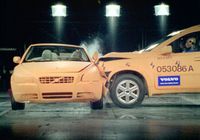Volvo Cars' World-Leading Crash-Test Laboratory Turns 10
SYDNEY – May 25, 2010: This year marks the 10th anniversary of Volvo Cars’ world-leading crash-test laboratory. In just one decade, nearly 3,000 full-scale crash tests have been carried out and the findings used to reduce the risk of being involved in an accident or being injured in a Volvo car by more than 50 percent.
"We can replicate most of the incident and accident scenarios that take place out on the roads. By analysing these and then testing new safety technology in the crash-test laboratory, we can improve the safety level in our cars so that they become even safer in real-life traffic conditions. The risk of being involved in an accident or being injured in one of our latest car models has been more than halved compared with a Volvo from the 1970s" says Thomas Broberg, senior safety advisor at Volvo Cars, Sweden.
“Volvo Cars’ crash-test laboratory is vital to our global vision – that nobody should die or suffer serious injuries in a new Volvo car by the year 2020” says Alan Desselss, managing director Volvo Car Australia.
Inaugurated by Sweden's King Carl XVI Gustaf in early 2000, it has retained its position as one of the most advanced testing laboratories in the car industry thanks to the continuous implementation of new equipment and new test methods.
The latest technology infusion is in the form of a set of digital high-speed cameras that can take 200,000 frames per second.
"The new cameras give us exceptional scope for studying collisions down to the tiniest detail. What is more, we have a number of miniature cameras that are installed inside the cars to capture what happens with various key components in the vehicle," says Thomas Broberg.
"The degree of precision in a test in which two moving cars collide at 50 km/h is 2.5 centimetres. This corresponds to two thousandths of a second. By way of comparison, a blink of the human eye takes about 60 thousandths of a second. This says a whole lot about the laboratory's precision," says Thomas Broberg.
The crash-test laboratory has one fixed and one movable test track, which can be adjusted from 0 to 90 degrees. This makes it possible to carry out tests involving a variety of incident and accident scenarios, from frontal impacts to side impacts, between two moving cars approach at different angles and speeds.
At the end of the fixed track there is a concrete slab that can be used for various tests such as rollovers and tests including avoidance or mitigation of a crash. At the end of the movable track, the surrounding landscape serves as an integrated part of the crash-test laboratory. Here crash tests are carried out against a variety of objects found in the traffic environment.
In addition to the lab's full-time employees Volvo Cars also has some 100 crash-test dummies of different types to represent men, women and children of different sizes, weights and ages.
"In order to offer cars with a safety level of absolute world class, we must ensure that our safety systems are suitable for different occupant sizes at a wide range of speeds and in various traffic situations. It is this ability to replicate incidents and accidents from real-life traffic situations that makes our Safety Centre special. The crash-test laboratory can also help verify the functionality of collision-avoiding technologies," says Thomas Broberg.
"By analysing these and then testing new safety technology in the crash-test laboratory, we can improve the safety level in our cars so that they become even safer in real-life traffic conditions” says Thomas Broberg.



